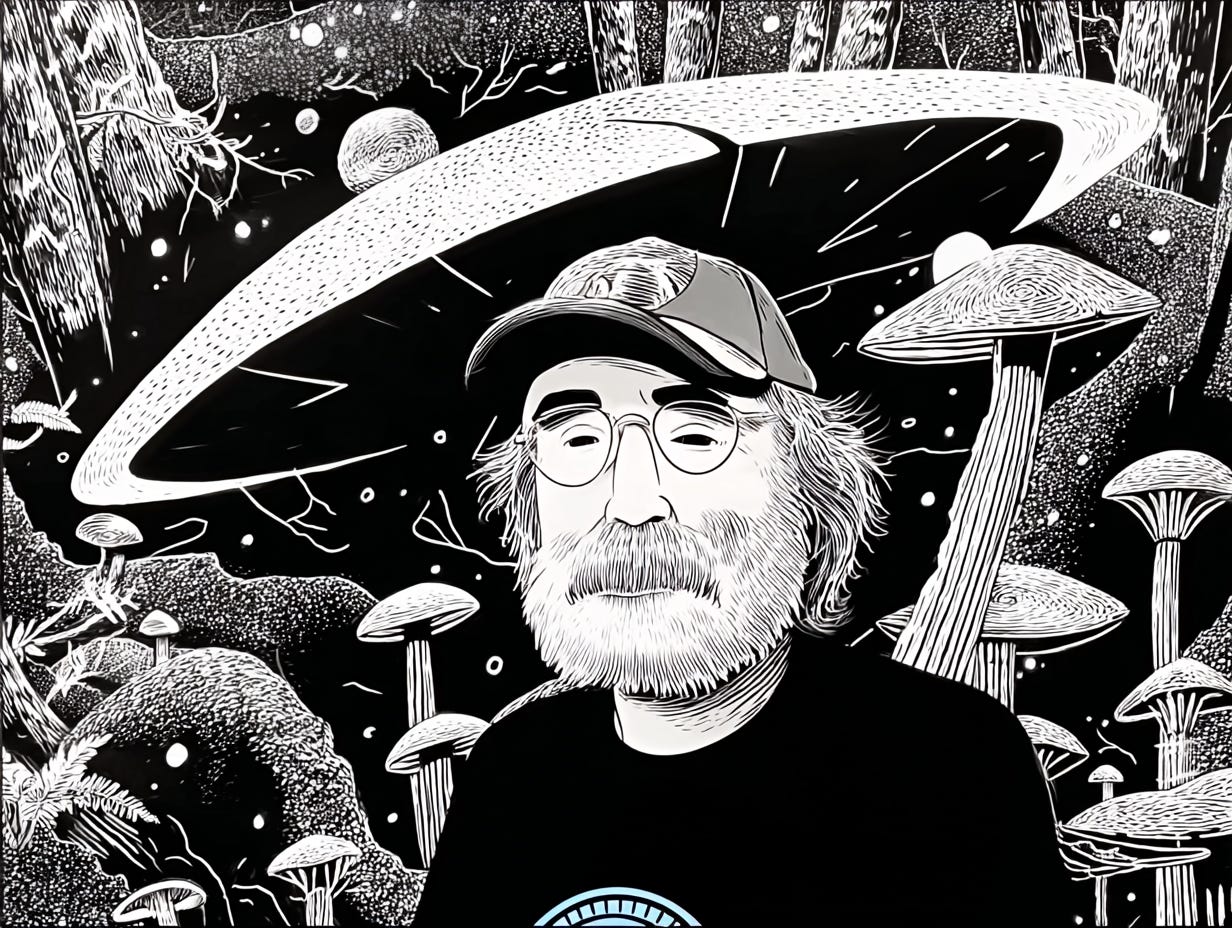What is the 'Stamets Stack' and does it Work?
Paul Stamets' regimen of microdosing psilocybin mushrooms with lion’s mane and Niacin - a look at the science
Microdosing psychedelics – taking tiny, sub-perceptual doses of substances like psilocybin, has surged in popularity as a tool for boosting mood, creativity, and mental clarity. Recently, we published the story of a miraculous recovery from a snow mobile accident that the writer credited to microdosing psilocybin mushrooms and thought it was a good time to take a closer look at one of the most popular microdosing regimens.
The “Stamets Stack” combines small doses of psilocybin containing mushrooms with the culinary-medicinal lion’s mane mushroom (Hericium erinaceus) and niacin (vitamin B3). This combination was popularized by renowned mycologist Paul Stamets, and many mushroom enthusiasts trust his advice. But what does science actually say about this intriguing trio? In this article, we take a scientific and inquisitive look at the Stamets Stack – exploring its origins, cultural context, proposed mechanisms, and the research (both modern and historical) examining its efficacy.
Origins of the Stamets Stack
Paul Stamets introduced the idea of stacking psilocybin, lion’s mane, and niacin as a way to promote “epigenetic neurogenesis,” essentially suggesting it could help the brain grow new cells and pathways. Stamets, an influential figure in the mushroom world, was motivated by the rise of neurodegenerative conditions like Alzheimer’s. He theorized that pairing psilocybin microdoses (to stimulate neuroplasticity) with lion’s mane (to spark nerve growth) and niacin (to improve delivery and nerve health) might synergistically enhance brain function and even repair neurological damage. Stamets has gone so far as to file patents on this combination, claiming it as a unique method for “enhancing neuroregeneration and cognition”. He even speculated in interviews that widespread use of such mushroom-based supplements could benefit not only the ailing but also healthy individuals – from students to athletes – by improving memory, sensory acuity, and coordination. These bold claims captured the imagination of many. However, they also raised eyebrows in the scientific community, given the lack of clinical trials at the time. To understand whether the Stamets Stack holds up, it helps to break down each component and see what evidence supports their effects.
What’s in the Stamets Stack?
At its core, the Stamets Stack is a three-part nootropic cocktail. Each ingredient is thought to play a distinct role:
Psilocybin Microdose (Magic Mushrooms): Psilocybin is the psychoactive compound in Psilocybe “magic” mushrooms. In a microdose (often about 0.1–0.3 g of dried Psilocybe cubensis, a very low amount), it’s sub-perceptual – meaning it doesn’t cause hallucinations or impair normal functioning. Stamets and others believe these tiny doses can gently enhance brain plasticity and emotional well-being. Laboratory research lends some plausibility: psychedelic compounds like psilocybin have been shown to promote the growth of neural connections in cell cultures and animal brains. For example, one study found that low doses of psilocybin in rodents stimulated new neuron growth in the hippocampus and improved the extinction of conditioned fear responses. Microdosers commonly report improved mood, focus, and creativity, which they attribute to these neural effects. Indeed, surveys have identified psilocybin as the most popular microdosing substance, often taken 3–5 times per week at ~1/10 to 1/20 of a full active dose.
Lion’s Mane Mushroom (Hericium erinaceus): Lion’s mane is a distinctive white, shaggy fungus long used in traditional Chinese and Japanese medicine for its supposed cognitive benefits. Modern science has begun to validate some of these claims. Lion’s mane contains compounds (hericenones and erinacines) that can stimulate nerve growth factor (NGF) production in nerve cells. In other words, it acts as a neurotrophic (nerve-growing) agent. Notably, a double-blind clinical trial in 50- to 80-year-old adults with mild cognitive impairment found that taking 3 grams of lion’s mane mushroom daily for 16 weeks led to significantly improved cognitive function compared to a placebo. The gains disappeared after the participants stopped taking the mushroom, suggesting a direct supportive effect. Another small placebo-controlled study in menopausal women who consumed lion’s mane mushroom cookies for 4 weeks reported reductions in feelings of anxiety and depression in the mushroom group. These benefits might arise through lion’s mane’s influence on brain nerve growth or possibly via other pathways (the researchers in this study noted the effect seemed to differ from NGF alone).
Overall, lion’s mane is emerging as a promising “brain tonic”, with animal studies showing it can enhance neurite outgrowth (the branching of nerve cells) and even improve memory in mice. Traditional herbalists weren’t far off – the mushroom was indeed used historically to “strengthen memory,” and recent lab work found that isolated lion’s mane compounds trigger robust neuronal growth and activate neurotrophic signaling pathways (like BDNF/TrkB). By including lion’s mane in the stack, Stamets aimed to provide the brain with building blocks for regeneration and cognitive enhancement.
Niacin (Vitamin B3): Niacin might seem like an odd addition – it’s simply a vitamin (B3), but Stamets argues it has a special role here. In the form of nicotinic acid, niacin causes a “flush,” a prickly heat sensation due to capillary dilation. Stamets hypothesized that this flush helps drive the mushroom compounds to the far reaches of the nervous system, potentially distributing psilocybin’s and lion’s mane’s effects to nerve endings throughout the body. Niacin is also essential for cellular energy metabolism (as a precursor to NAD⁺) and has been linked to brain health. One large epidemiological study found that higher dietary niacin intake was associated with a lower risk of Alzheimer’s disease and age-related cognitive decline. Additionally, niacin has anti-inflammatory properties and can promote blood flow by widening blood vessels. Stamets suggests these qualities could amplify neurogenesis: better circulation might help deliver lion’s mane’s NGF-boosting compounds and psilocybin’s neuroplastic effects more effectively to the brain and nerves. An interesting side-benefit he notes is that niacin’s intense flushing effect may act as a safeguard against overuse – if someone tries to take high doses of psilocybin using the stack, the uncomfortable flush would deter them.
In practice, Stamets’ recommended stack protocol is to take these three components for a few days on, then a few days off. A commonly cited schedule is 4–5 consecutive days of microdosing, followed by 2–3 days off to reset.
A typical “dose” might be on the order of ~0.1 g of Psilocybe cubensis mushrooms (dried), 0.5–1 g of lion’s mane (as supplement powder or capsules), and about 50–100 mg of niacin. Stamets emphasizes adjusting the amounts to one’s body weight and sensitivity, and always staying well below any hallucination threshold for psilocybin. Also, it’s important to note that each species and strain of psilocybin mushroom will contain varying amounts of psilocybin- with some of the wood-loving species being particularly strong.
The goal is gentle, sustained neural enhancement – a far cry from a full-on psychedelic trip.
Psilocybe cubensis is often used in psilocybin microdosing regimens. Enthusiasts of the Stamets Stack believe that combining a psilocybin microdose with lion’s mane and niacin creates a synergistic effect: psilocybin potentially sparks brain plasticity and novel connections, lion’s mane provides nutrients and growth factors to support new neural growth, and niacin boosts circulation to help spread these effects and support overall brain cell function. It’s a fascinating hypothesis – but how does it stack up against scientific scrutiny (pun intended)?
Keep reading with a 7-day free trial
Subscribe to North Spore | Media to keep reading this post and get 7 days of free access to the full post archives.



